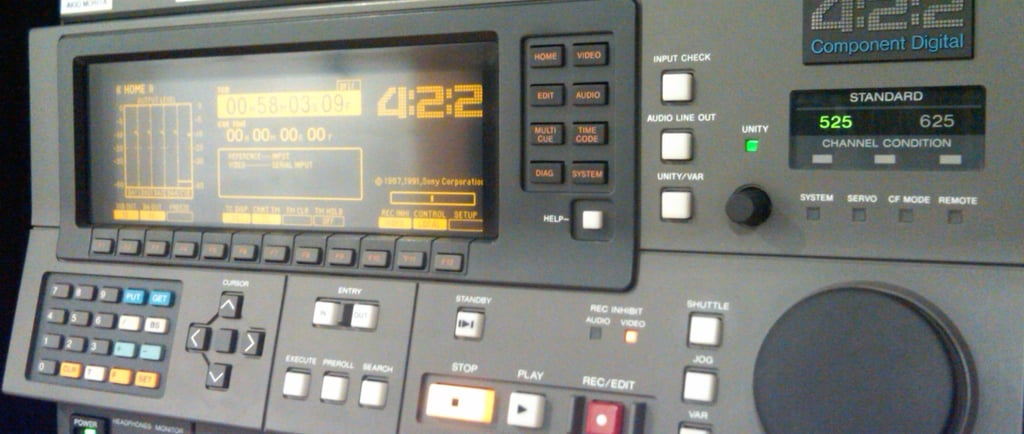Preparing for the history of tomorrow


If you are of a certain vintage, you may remember an animated television series called ReBoot. Running from 1994-1998, ReBoot was set in the inner world of a computer with the main characters battling computer virus villains. The series was created entirely with computer generated imagery (CGI) and gained a dedicated following. Mainframe Entertainment, the Vancouver-based company behind ReBoot, was also behind the CGI characters featured in the music video for the Dire Straits hit “Money for Nothing”.
Recently, the team behind an upcoming documentary about ReBoot unearthed the original master tapes for the series. Rendered on PAL D-1 tape cassettes, the discovery was met with excitement, but posed a big challenge – the production company no longer had the type of tape deck required to play those tapes. While the documentary team has put the word out to try and find the correct deck, the footage remains unviewable until the correct technology needed to read it is found.
ReBoot is an interesting example of where technology meets the preservation of history. Digital formats have changed rapidly over time, leaving some formats essentially orphaned without the technology to read them. As well, certain digital formats degrade as copies are made, making the storage of the original digital copy an important consideration. Besides not being able to read the original PAL D-1 master tapes of ReBoot, the tape itself may be nearing the end of its useable lifespan. Being able to transfer the data off those tapes will, hopefully, yield a copy that is as close as possible to the original for preservation.
You may be wondering about why there would be such an interest in a cartoon from the 90s. It turns out, ReBoot does carry some historical significance. It was one of the first television series produced entirely using CGI, representing a milestone in, as well as a major Canadian contribution to, television history. It has taken a group of interested and dedicated enthusiasts to bring about even the potential for this bit of Canadiana to be preserved for posterity.
The sheer volume of digital data generated over the last half-century that might be deemed worthy of historical preservation is massive. The Library of Congress attempted to archive years of tweets from the social media platform formerly known as Twitter before storage limitations and changes to tweet formatting made the project unfeasible. The Internet Archive, with its Wayback Machine, attempts to preserve website data but is limited by how much of the vastness of the internet its bots can crawl. Wikipedia, a huge tome of information, has notability guidelines for what warrants a stand-alone article. How many points of view are lost in the undertow of this surfeit of digital history? What is deemed remarkable enough to keep?
What we keep and how we keep it is an ongoing question in our society and has been since long before anything digital. Those decisions can have weighty social consequences. We often see history as immutable, but it is based on a series of decisions made by our institutions and society reflecting a specific point of view. Naming a small Ontario town after a humourist who never set foot there, while failing to recognize the many hundreds of years of Indigenous history in the area, were decisions. Decisions on what to preserve, commemorate, and celebrate, are very often made by people with means and power resulting in a historical perspective that is at best incomplete and at worst damaging.
Technology can at least help give a voice to those whose history has gone unrecognized. For example, the National Centre for Truth and Reconciliation has an online archive documenting Residential Schools in Canada and the reconciliation process. The Tulsa Historical Society and Museum houses an online exhibit commemorating the 1921 Tulsa Race Massacre in which white rioters nearly destroyed the Greenwood District of Tulsa, Oklahoma, known as Black Wall Street, killing hundreds of black Tulsans. These digital collections help provide wider access to physical collections along with analysis.
Today, much of what may someday be an artefact is born digital. To this end, digital archive projects work to preserve social media posts, videos, and other digital ephemera. For example, Arizona State University’s Journal of the Plague Year crowd sources COVID-19 pandemic experiences and includes a collection focusing on the experience of the LGBTQ+ community, ensuring this perspective won’t be overlooked by history.
While we might romantically view history through a lens of handwritten letters and grainy photographs, advances in technology mean that what might become the historical record will include a diverse collection of ideas, formats, and voices. How we preserve this history is a problem we need to deal with now so that researchers in the future can truly learn about how we lived today.
Image by Keoni Tyler CC BY-SA 3.0
Learn more
Correction log
Nothing here yet.
Alphanumeric: Documentary about fan-favourite "ReBoot" coming in 2024. 2023. Daniel Chai. (DailyHive) Last accessed 2024/01/16.
Historical Archives Once Silenced Marginalized Voices. Now Pandemic Archivists Want Them to Be Heard. 2020. Marc Parry. (Chronicle of Higher Education) Last accessed 2024/01/16.
A Journal of the Plague Year - LGBTQ-Issues. Last accessed 2024/01/16.
1921 Tulsa Race Massacre. Tulsa Historical Society and Museum. Last accessed 2024/01/16.
Wikipedia:Notability. Last accessed 2024/01/16.
Dysart keeps Sam Slick reference in park’s name. 2023. James Matthews. (Haliburton Echo) Last accessed 2024/01/16.
An Educational Session and Proposal for Sam Slick Park. 2022. Dysart et. al. Cultural Resources Committtee and Social Justice and Equity Class - Haliburton Highlands Secondary School. (CivicWeb) Last accessed 2024/01/16.